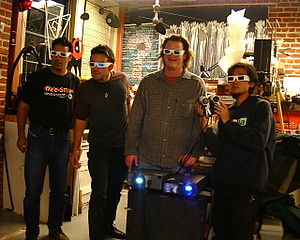Anyone who has shot video for a while eventually wants a way to create

smoother handheld shots. I do a lot of my shooting while on my feet and walking, just the type of activity for which “steadicam” (steadycam) units are built.
But do inexpensive camera stabilizers deliver real value?
I have not tested them but this guy has and he suggests they are not worth the money relative to the alternatives (yes, there are alternatives!):
For example, I use either my Manfrotto tripod and video head (about 8.5 pounds) or my monopod with a 3 or 4 pound weight at the bottom and get good results. I also have a home made setup with some pieces of pipe from the plumbing shop and a 2 1/2 or 5 pound weight at the bottom – this works best of all! For the monopod weight I use the athletic weight straps designed for walkers and runners. These “rollup” around the base of the monpod and are held in place with Velco linings. Available at any sporting goods store.
The trick is not so much the equipment but how you use it. First, you need a really wide angle lens. I use a c-mount 4mm lens on my GH-2, which works out to about a 21mm full frame equivalent lens. A lot of the really smooth walking scenes you see on TV or the Internet are often done with extreme wide angle lenses, such as a 16mm full frame equivalent. Wide angle lenses make the biggest difference and you are probably better off investing in a good wide angle lens than steady cam.
Heavier cameras also stabilized better than lighter ones. I get better results using my Canon XH A1 (about 5 pounds) than the little GH-2. But you will get physically tired, faster, with the heavier camera (I’ve carried the XH A1, on an 8.5 pound tripod, with a 3 pound weight, for several miles while shooting a parade. Do remember to do strength conditioning starting months in advance!)
Second, you need to learn how to walk, and this takes practice. Bend your knees, may be tilt slightly forward and hold your arms out slightly bent. Roll your feet as you walk (known as “roll stepping”). Walking backwards can be smoother than walking forwards.
Third, you can apply motion stabilization in your video editor. Most software now has good to very good stabilization algorithms. If you do this, use the minimum stabilization possible (too much and you end up cropping or re-sizing your original image and it ends up looking strange).
A good stabilizer, however, when properly used, is going to produce better results than the simple monopod or tripod with a weight. The question of you is, “What is your budget?” and “How often will you use it?”
Update: I have an idea for a simple add on to a monopod that may decouple many walking movements between the camera operator and the camera. I have some parts on order and will let you know how it turns out – if it runs out okay 🙂
Related articles
- EZ-Steady camera stabilizer finds massive KickStarter support pre-launch (slashgear.com)
- DIY iPhone 4 steadycam rig is simple, awesome, cheap (intomobile.com)
- Sony vows new full-frame Alpha, adds 500mm lens and roadmap (electronista.com)
- Winter II … It’s still cold. (blogjoedimaggio.com)
- Image Stabilization Trickles Down (technologyreview.com)
- How To Shoot Steadicam Video – Extreme Adventure Clips by Sebastien Montaz-Rosset (highballblog.com)
- How To Shoot Amazing Nature and Extreme Sports DSLR Videos – Tips from Devin Graham (highballblog.com)
- How To Build a Cheap Steadicam – Glidecam for Your GoPro HD Camera (highballblog.com)




